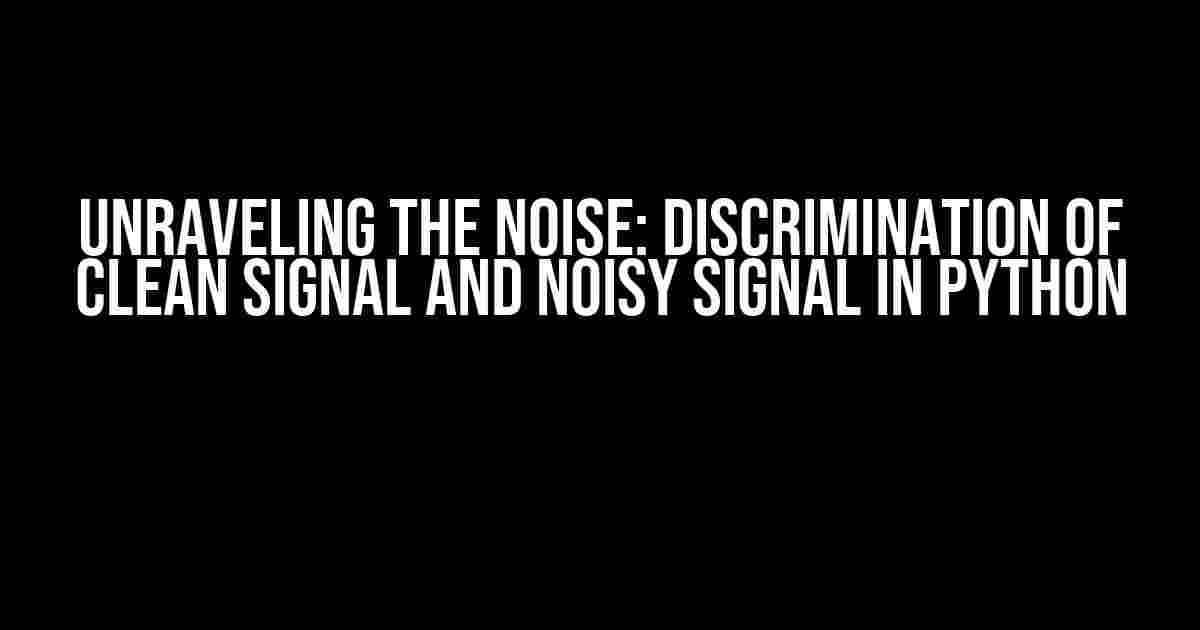As data scientists and machine learning enthusiasts, we’ve all been there – staring at a noisy signal, wondering how to separate the wheat from the chaff. In this article, we’ll dive into the world of signal processing and explore the discrimination of clean signal and noisy signal in Python. Buckle up, folks, as we’re about to get our hands dirty!
What is a Signal?
In simple terms, a signal is a representation of information that varies with time or space. Think of a signal like a message that’s transmitted through a medium, like sound waves through air or electrical impulses through a wire. In the context of signal processing, we can categorize signals into two types:
- Clean Signal: A signal that accurately represents the original information, free from any distortions or interference.
- Noisy Signal: A signal that’s contaminated with unwanted disturbances, making it difficult to extract the original information.
The Problem: Noise Corruption
Noise corruption can occur due to various reasons, such as:
- Instrumental errors during data collection
- Environmental interference (e.g., electromagnetic radiation)
- Channel noise during transmission
- Quantization errors during digitization
When noise corrupts a signal, it can lead to inaccurate analysis, poor model performance, and misleading conclusions. That’s why it’s crucial to develop techniques to discriminate between clean and noisy signals.
Techniques for Signal Discrimination
Now, let’s explore some popular techniques for signal discrimination in Python:
1. Time-Domain Analysis
In time-domain analysis, we examine the signal’s properties in the time domain, such as amplitude, frequency, and phase. We can use Python libraries like SciPy and NumPy to perform time-domain analysis.
import numpy as np
from scipy import signal
# Generate a clean signal
t = np.linspace(0, 1, 1000)
clean_signal = np.sin(2 * np.pi * 10 * t)
# Add noise to the signal
noisy_signal = clean_signal + 0.5 * np.random.randn(len(t))
# Calculate the power spectral density (PSD) of the signals
clean_psd = signal.periodogram(clean_signal)
noisy_psd = signal.periodogram(noisy_signal)
# Plot the PSDs
import matplotlib.pyplot as plt
plt.plot(clean_psd)
plt.plot(noisy_psd)
plt.xlabel('Frequency')
plt.ylabel('Power')
plt.legend(['Clean Signal', 'Noisy Signal'])
plt.show()
2. Frequency-Domain Analysis
In frequency-domain analysis, we transform the signal into the frequency domain using techniques like Fast Fourier Transform (FFT). This allows us to identify specific frequency components and filter out noise.
import numpy as np
import matplotlib.pyplot as plt
# Generate a clean signal
t = np.linspace(0, 1, 1000)
clean_signal = np.sin(2 * np.pi * 10 * t)
# Add noise to the signal
noisy_signal = clean_signal + 0.5 * np.random.randn(len(t))
# Perform FFT on the signals
clean_fft = np.fft.fft(clean_signal)
noisy_fft = np.fft.fft(noisy_signal)
# Plot the FFT spectra
plt.plot(np.abs(clean_fft))
plt.plot(np.abs(noisy_fft))
plt.xlabel('Frequency')
plt.ylabel('Amplitude')
plt.legend(['Clean Signal', 'Noisy Signal'])
plt.show()
3. Filter-Based Methods
Filters can be used to remove noise from a signal. Some popular filter-based methods include:
- Low-Pass Filter (LPF): Removes high-frequency noise
- High-Pass Filter (HPF): Removes low-frequency noise
- Band-Pass Filter (BPF): Removes noise outside a specific frequency range
import numpy as np
from scipy import signal
# Generate a clean signal
t = np.linspace(0, 1, 1000)
clean_signal = np.sin(2 * np.pi * 10 * t)
# Add noise to the signal
noisy_signal = clean_signal + 0.5 * np.random.randn(len(t))
# Design a low-pass filter
b, a = signal.butter(4, 0.2, 'lowpass')
# Filter the noisy signal
filtered_signal = signal.lfilter(b, a, noisy_signal)
# Plot the original and filtered signals
import matplotlib.pyplot as plt
plt.plot(noisy_signal)
plt.plot(filtered_signal)
plt.xlabel('Time')
plt.ylabel('Amplitude')
plt.legend(['Noisy Signal', 'Filtered Signal'])
plt.show()
4. Machine Learning Approaches
Machine learning algorithms can be trained to classify signals as clean or noisy. Some popular approaches include:
- Support Vector Machines (SVMs): Can be used for binary classification
- K-Nearest Neighbors (KNN): Can be used for regression-based signal classification
- Convolutional Neural Networks (CNNs): Can be used for signal classification using convolutional layers
import numpy as np
from sklearn import svm
from sklearn.model_selection import train_test_split
# Generate a clean signal
t = np.linspace(0, 1, 1000)
clean_signal = np.sin(2 * np.pi * 10 * t)
# Add noise to the signal
noisy_signal = clean_signal + 0.5 * np.random.randn(len(t))
# Split the data into training and testing sets
X_train, X_test, y_train, y_test = train_test_split(noisy_signal, clean_signal, test_size=0.2, random_state=42)
# Train an SVM classifier
svm_classifier = svm.SVC(kernel='linear', C=1)
svm_classifier.fit(X_train.reshape(-1, 1), y_train)
# Evaluate the classifier
accuracy = svm_classifier.score(X_test.reshape(-1, 1), y_test)
print(f'Accuracy: {accuracy:.2f}')
Conclusion
In this article, we explored the discrimination of clean signal and noisy signal in Python using various techniques, including time-domain analysis, frequency-domain analysis, filter-based methods, and machine learning approaches. By understanding these techniques, you’ll be better equipped to handle noisy signals and extract valuable insights from your data.
Remember, the key to successful signal discrimination lies in selecting the right technique for your specific problem. Experiment with different methods, and don’t be afraid to get creative!
References:
- SciPy Documentation: Signal Processing
- NumPy Documentation: Fast Fourier Transform
- Scikit-Learn Documentation: Support Vector Machines
Happy signal processing!
Frequently Asked Question
Get ready to dive into the world of signal processing and learn how to differentiate between clean and noisy signals in Python!
Q1: What is the difference between a clean signal and a noisy signal?
A clean signal is a pure signal without any external interference or noise, whereas a noisy signal is a signal that contains unwanted or disturbing components, such as random fluctuations or errors. In Python, we can use libraries like NumPy and SciPy to generate and analyze signals.
Q2: How can I visualize a signal in Python to identify if it’s clean or noisy?
You can use matplotlib, a popular Python plotting library, to visualize your signal. A clean signal typically has a smooth and periodic pattern, while a noisy signal has random fluctuations. You can use plots like time-domain plots, frequency-domain plots (e.g., FFT), or even spectrograms to identify the characteristics of your signal.
Q3: What metrics can I use to quantify the difference between a clean signal and a noisy signal in Python?
Some common metrics used to quantify the difference between clean and noisy signals include Signal-to-Noise Ratio (SNR), Peak Signal-to-Noise Ratio (PSNR), Mean Squared Error (MSE), and Root Mean Squared Error (RMSE). These metrics can be easily implemented in Python using NumPy and SciPy functions.
Q4: Can I use machine learning algorithms to classify clean and noisy signals in Python?
Yes, you can use machine learning algorithms, such as classification models, to distinguish between clean and noisy signals. Feature extraction techniques, like time-domain or frequency-domain features, can be used to extract relevant information from the signals. Then, you can train a model using libraries like scikit-learn or TensorFlow to classify the signals as clean or noisy.
Q5: Are there any specific Python libraries or tools that can help me with signal processing and noise reduction?
Yes, there are several Python libraries and tools that can help you with signal processing and noise reduction. Some popular ones include SciPy, NumPy, Pandas, Matplotlib, scikit-signal, and PyWavelets. These libraries provide functions for filtering, convolution, Fourier transforms, and more, which can be used to analyze and denoise signals.


